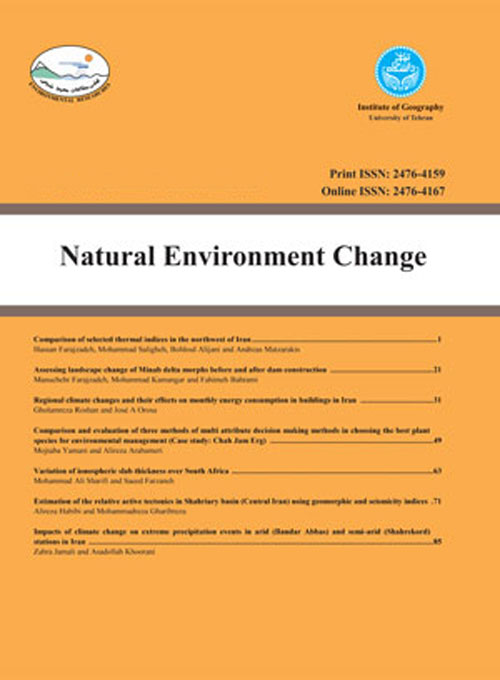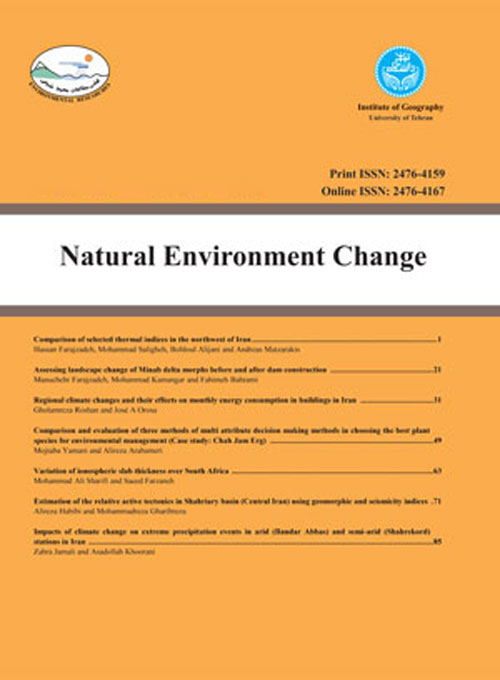فهرست مطالب

Natural Environment Change
Volume:2 Issue: 2, Summer - Autumn 2016
- تاریخ انتشار: 1395/08/28
- تعداد عناوین: 8
-
Pages 89-98Objective of this study is to determine whether there are significant changes in maximum temperature trends between the current (1981-2010) and future (2011-2099) periods. To this end, statistical downscaling is used to project future changes in the maximum temperatures according to A2 and B2 scenarios of HADCM3 in the 7 selected stations of Iran. The possibilities of an accelerating trend are detected in the maximum temperature at 95% confidence level using of MannKendall and Sens slope methods. The results showed that there is an increasing tendency in the maximum temperature trends over Iran, especially in the northern highlands for the future decades of the 21st century than the last three decades. The highest trend slopes in annual maximum temperatures are found by 0.69, 0.68, and 0.62°C per decade at Isfahan, Tabriz, and Tehran stations based on A2 scenario for the future decades (2011-2099), respectively, while the lowest trend slope is found at B-Abbas station that is equivalent to 0.14°C per decade based on B2 scenario. It is important to mention that the rate of warming trend will be accelerating based on temperature-time relations in coming decades. In this point, the future occurrences of desirable daily temperatures could be exposure in the southern coasts of Iran where it will be affected by more capacity of atmospheric humidity.Keywords: current decades, future decades, temperature trends, warming rate
-
Quantitative assessment of relative tectonic activity in the Alamarvdasht river basin, south of IranPages 99-110Tectonic processes are major factors controlling landform development in tectonically active areas. In order to evaluate quantitative measurement of tectonic activities in the Alamarvdasht basin in the south of Iran, six different morphological indices including stream-gradient index (SL), drainage basin asymmetry (Af), hypsometric integral (Hi), valley floor width-valley height ratio (Vf), drainage basin shape (Bs) and mountain-front sinuosity (Smf) were calculated. These indices were combined to generate the relative active tectonics index (IAT) and the study area was divided into three classes: high, moderate and low relative tectonic activity based on IAT values. The results of IAT index showed that high and moderate tectonic activity areas are located near the main faults and anticlines. The results are also consistent with geology and field observations on landforms and GPS data of Lamerd geodynamics station. GPS data shows subsidence and north-eastern movement in the basin because of convergence between the Arabian and Eurasian plates in the Zagros Mountains zone.Keywords: Alamarvdasht basin, geodynamics, geomorphic indices, relative active tectonics, tectonic geomorphology
-
Pages 111-125Drought as a natural but temporary imbalance of water availability is the interaction between natural environment and human life resulting in diminished water resources availability and reduced carrying capacity of the ecosystems. Drought indices are essential elements for an efficient drought monitoring system. These indices make the transforming information of climatic anomalies easier and allow the scientists to quantitatively assess the climatic anomalies. In this research drought condition in Hormozgan province, Iran based on RDI and SPI was studied and the effects of drought on groundwater resources have been studied as well. The highest correlation in almost all plains is related to long term periods (24 months) which show that drought becomes more important and hazardous in long term periods. However higher correlation of some plains like Minab plain with RDI&SPI 3 month shows the quick response of this plain to the meteorological droughts. The results are very useful tool for planners and decision makers to monitor the region based on its susceptibility to drought.Keywords: drought, groundwater, index, standardized precipitation index
-
Pages 127-142The morphology of glacial valley can be described in terms of power law or quadratic equations fitted to valley cross-profiles. These two models are used to study the cross-profiles of 86 valley cross-profiles in the Zardkuh Mountain in order to understand the evolutional patterns of valleys. Assessment of using the power law function indicates that b values for both valley sides range from 1.0 to 2.5 with values showing an increase within this range as valley floor altitude increases. Analysis of b and FR of the valleys in the Zardkuh Mountains does not fit in with the Rocky Mountain model of Hirano and Aniya, but has a similar trend to the Patagonia-Antarctica model. The analyses also show a more efficient widening process in higher altitudes and a more efficient over deepening of valleys in lower altitudes. The results of the analysis show a relatively efficient glacial process in the elevated region of the Zardkuh. Application of quadratic function show similar conclusions and also indicates that most of the valleys are roughly symmetrical in the cross-profile. Apparently, greatest degree of "U-ness" showing glacial modifications was observed in altitudes above ELA during Last Glacial Maximum.Keywords: glacial valley, power law function, quadratic function, Zardkuh
-
Pages 143-152In this paper, according to the data of 17 weather stations in Khuzestan during 19512012, the trend of climate changes and its severity were evaluated. A consistent correlation was highlighted for trends of De Martonne index as indicator of climate and temperature index in some stations. Based on the results of the temperature analysis, 88.31% of the Province became warmer, 6.3% became colder, and 5.3% did not show significant changes. The precipitation in the 7% of the province increased, in 67.2% of the area decreased, and 25.8% of the province did not show any significant changes. About the climate changes: 67.2% of Province became drier and 32.7% of the area showed no significant changes. A hazard classification was used for climate change based on trends of temperature and the aridity index of De Martonne during the period. The results showed 18.8% under moderate class, 40.3% under severe class, and 40.9% very severe class. This contribution provided the first experimental data-based evidence demonstrating the link between the global warming and the intensification of aridity in most parts of Khuzestan. This finding concluded more desertification and frequency and intensity of droughts.Keywords: climate change, De Martonne index, Khuzestan, temperature
-
Pages 153-164Drought is one of the most important weather-induced phenomena which may have severe impacts on different areas such as agriculture, economy, energy production, and society. A number of drought indices have been introduced and used in various countries to date. In the current study, four meteorological drought indices including Percent of Normal Precipitation Index (PNPI), Standard Index of Annual Precipitation (SIAP), Rainfall Anomaly Index (RAI), and Standardized Precipitation Index (SPI) are compared and evaluated for monitoring droughts in Lake Urmia Basin in Iran. The comparison of indices was carried out based on drought classes that were monitored in the study area using 40 years of data (1966-2005). Two well-known probability approaches including Runs theory and Markov chain model, were used to estimate the probability of wet and dry periods. The frequency matrix is formed and the transition probability matrix of wet- dry spells is created accordingly based on maximum likelihood method. The equilibrium probability is calculated based on succeed power on probability matrix. The results demonstrated that among the drought indices, PNPI is not an appropriate index in annual estimates and SPI and RAI are better than other indices and their results are nearer to reality. The results indicated the equilibrium probability of very dry, dry, normal, wet and very wet periods is obtained 0.23, 0.27, 0.23, 0.17 and 0.1, respectively.Keywords: drought, Lake Urmia basin, Markov chain, PNPI, RAI, runs theory, SIAP, SPI
-
Pages 165-175The Universal Thermal Climate Index (UTCI) addresses these shortcomings by using an advanced thermo-physiological model. The aim of this study was to investigate and prepare zoning of thermal comfort condition using UTCI. Meteorological data including temperature, wind speed, cloudiness and relative humidity were obtained on a daily time scale from 10 synoptic stations during (2004-2013) period. For the calculation of UTCI index Ryman and Bioklima softwares were used. Then the relationship between UTCI and elevation was investigated and by using Digital Elevation Model (DEM), UTCI zoning was prepared. The results showed that there is a strong inverse relationship between UTCI and elevation. Spatial and temporal zoning maps showed the highest values of UTCI were observed in the northeastern part of province (Sarakhs station) on July. In the cold months the lowest values of UTCI has been recorded in January. Extreme heat stress was observed across the East, South and South-East of Khorasan Razavi province. While cold stress has been more dominant In the Central and northern areas of the province. Generally there is a significant correlation between the thermal comfort and elevation, so that thermal stresses are often observed in the low regions in the warm period of the year.Keywords: Khorasan Razavi, thermal stress, UTCI
-
Pages 177-186It is increasingly recognized that the land-use change, especially urbanization has influenced hydrological attributes intensely. But in most urban designs, flood prediction is considered through type of land use (residential, industrial, and so on) and density. However, experiences show that this method has not been very successful. As a result, the present study aims to investigate and explore a different method in Birjand city. The study primarily emphasizes on the relationship between parameters of hydrologic models and features of urban development as well as scenarios considered in comprehensive plan. Data required for the study were obtained through investigation of existing documents and studies, particularly regarding comprehensive plan of Birjand City. Evaluation has been performed using urban hydrologic models and applying geographic information systems regarding prediction of surface currents corresponding to different urban scenarios. The results showed that in comprehensive plan the effects of increasing impervious surfaces and their effect on increasing water runoff have not been emphasized. This issue has led to an increase in runoff and consequently flooding. The model used in the study indicated that in heavy rains with return period of 25 years, flooding is mainly associated with blocking of water flow at the mouth of bridges. Moreover, this method is compatible enough with conditions of Iran and can be used in similar situations.Keywords: Birjand City, development features, type of land use, urban designs, urban floods


